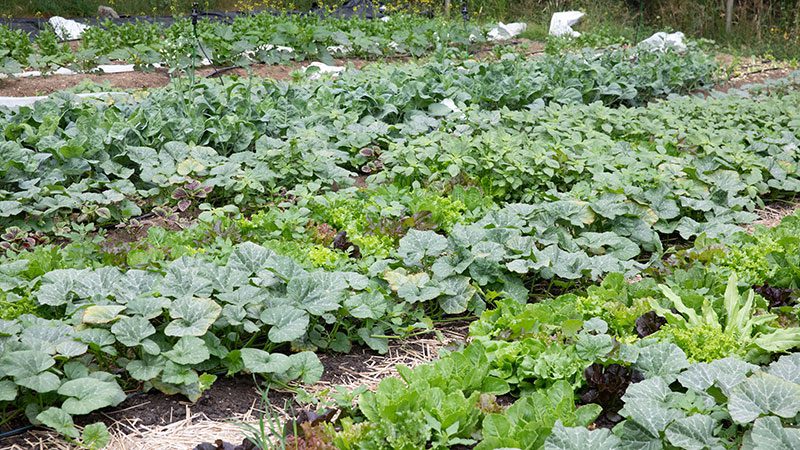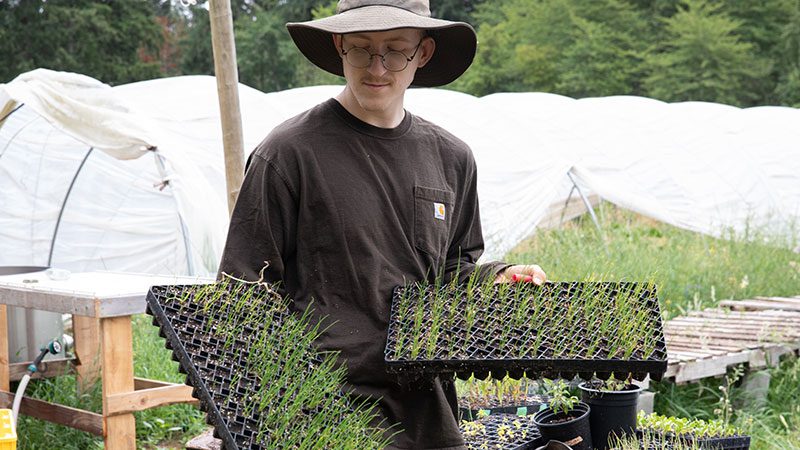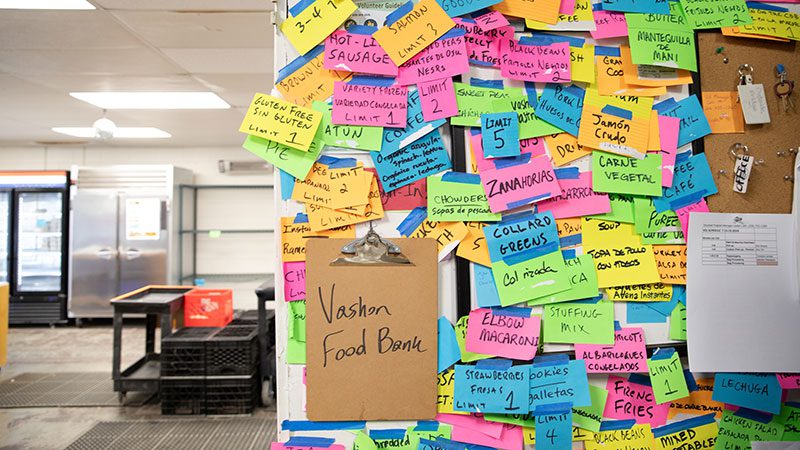Growing for Good Partnership Nourishes an Island

Just four miles of tree-lined roads separate Tian Tian Farm from the Vashon-Maury Community Food Bank. Tian Tian was founded on Vashon Island in 2021 with a specialty in Asian vegetables. Rows of a-choy greens and thick-stemmed celtuce, daikon radish and gai lan (Chinese broccoli), pea vines and amaranth thrive on the one-acre plot founded by Elizabeth Whitman and Steven Hsieh. Some of their vegetables travel just a few feet to the on-site farmstand, others are harvested for outlets like a Community Supported Agriculture (CSA) farmshare.
Last year, the farmers expanded into a new community outlet, providing the island food bank with fresh local produce: robust kale, eggplants, turnips, cucumbers, onion and more. That partnership is the latest addition to Growing for Good (GFG), a collaboration created in 2020 by PCC, the Neighborhood Farmers Markets, and Harvest Against Hunger. Growing for Good allows food banks to purchase food directly from farmers – in many cases, arranging with the farmers to grow specific crops that meet community needs. Community members contribute to Growing for Good by rounding up purchases to the nearest dollar at PCC cash registers.
Making food accessible
Growing for Good’s earlier partnerships came through existing food bank partnerships at PCC stores. There’s no PCC on Vashon, but the program is a regional one, and other nonprofits needed a broader range of Asian vegetables while the island food bank had a need for local produce. When a connection at Seattle’s Neighborhood Farmer Markets asked if they were interested. “We definitely were, because we want our food to be accessible to as broad a range of people as possible,” Whitman said.
A particular joy for Whitman and Hsieh is growing food that’s culturally relevant for recipients, such as the abundant, leafy a-choy greens, a Taiwanese staple that’s often stir-fried. Sometimes people at their markets will say “I have no idea what that is, but I’ll try it.” Some are familiar with it and buy it as a matter of course. But sometimes, especially with Growing for Good clients like Seattle’s Asian Counseling and Referral Service, they can hear the thrill in people’s voices as they see it: “Yes! A-choy!” For those who grew up eating a-choy and haven’t been able to find it fresh or afford it, that excitement is hugely rewarding.
The growers recognize the constant conundrum of sustainable farming, that fresh, healthy, responsibly grown food costs more than the alternatives. Some households can stretch their budgets to make it fit, some can’t.
“The farmers market is out of reach to such a broad swath of the population,” Hsieh said.
“And our CSA is too, honestly,” added Whitman.
The new partnership was helpful on the flip side, too, helping Tian Tian gain a solid financial boost.
Through Growing for Good, food banks can essentially order the crops they want farmers to plant. The farmers are paid up front, when money is typically tight.
“Early in the season is when we have all of our expenses, like the seed, the compost, and less income coming in because there’s just not a lot of production happening,” Whitman said.

The farming crisis
Anything that helps make farming a sustainable business is a boon in the U.S., where the aging population of American farmers — and the unattainable price of land — has been a nagging and growing crisis.
Whitman and Hsieh founded Tian Tian alongside careers in journalism, settling on the Vashon land through the Washington Farmland Trust’s Farm to Farmer program. Walking through their roughly one-acre plot on a late-summer day, blooming white allium heads waved in the breeze as petite eggplants and sweet cherry tomatoes ripened on the vines. Whitman identified the various stages of the plantings: winter squash plants alternating with rows of lettuce, baby bok choy, even a small test of barley from a worker who planned a trial of homebrewed beer using the fresh hops at the fence line. Environmental consciousness is built into the farm, from low-till and no-till farming to recycling and reusing materials.
Vashon has a pastoral reputation as a slow-paced, artsy, independent haven where you’re never far from a view of mountains and Sound. But it’s been subject to the same pressures as the rest of the region. Affordable Vashon housing is extra-scarce. The overall cost of living is high. Ferry delays and outages complicate business schedules — tough for a business based on perishable products.
Tian Tian’s plot has been regularly used for food production — including some years when the food bank gardened there — and it came with deer fencing and some other helpful basis. And yet, there were still struggles. Contracts like Growing for Good helped support the farm’s expansion and helped Hsieh and Whitman determine what they could and should plant.
Simpler, larger harvests — the food bank needs about 250 of each item to supply it to all clients — were a benefit too, from paperwork to production.
“It really does help with our crop planning, in that we can just dedicate a couple of beds to a large quantity of something,” Hsieh said. “It’s also really great for harvest, because we can more efficiently get through a couple of beds. You don’t think about it up front, but when you’re in the midst of a harvest, just being able to do one motion, and one simple motion, for an extended period, you get a lot more done.” It saves administrative time too; that work is the same whether they’re selling $100 worth of food or $1000.

An island food bank
The Vashon food bank, established in the late 1970s, has a long history of prioritizing island-grown produce for its clients, but most local growers operate on a micro-scale.
“We could hypothetically purchase little bits from a bunch of farms,” said executive director Emily Scott, but buying, say, “six pounds of cucumbers” each from a handful of sources may not be worth the administrative muscle. The Growing for Good relationship, more like a bulk wholesale arrangement, is more workable. A weekly Charlie’s Produce order ensures staples like potatoes and onions are available.
On Sunrise Ridge, a former military property, the food bank currently consists of a small grocery-style setup where residents can visit once a week for food. Colorful handmade signs list everything from stuffing mix to strawberries, hung on the wall waiting for the weeks those products come in from partners like Food Lifeline. Separate cinderblock structures house walk-in freezers and storage areas for grain, and other facilities supplying a building that’s outgrown its purpose.
The aged former military structures “are kind of just falling apart,” Scott said.
“They were not intended to last as long as they have.”
Sunrise Ridge also serves as the staging ground for the food bank’s extensive home delivery service. It used to be “kind of a secondary program” bringing groceries to 25 or 30 island households per week, said Scott. Use skyrocketed during the COVID-19 pandemic, and the food bank still makes weekly deliveries to about 130 homes.
“Especially on Vashon in this small town, I think it helps people get over the barriers of either transportation or the unfortunate stigma of using a food bank. We can get food directly to people’s homes, it makes it more accessible,” Scott said.
The need for general food bank services has grown dramatically. It now serves at least one in every seven Vashon households.
“It’s higher right now than even just this time last year. People talk about, like, oh, inflation is easing, but… everything is still really expensive,” Scott said.
A $7 million capital campaign is underway to move the food bank to a new facility in Vashon’s small downtown, renovating an existing building and building a new food bank and warehouse. (Donations to the Vashon Food Bank can be made here.)
Currently, “we’re a couple miles out of town, a quarter-mile up a hill on gravel, and accessibility is limited in a lot of ways” on top of the aging facilities, Scott said. To be close to other services, on the bus line, “in a facility that is actually purposely built for human and food management,” should make a big difference.
“We serve over 15% of the island on an annual basis, and we think we should be able to do so in a way that reflects the dignity we think people deserve.”
The tiny starter seedlings waiting for planting at Tian Tian, plus the overwintering crops, are already a help.
“I think anybody would like — would love — to be able to eat something grown right next door.”
Support Growing for Good
Support Growing for Good by rounding up at the register at all PCC stores. Additionally, PCC will donate $10 to Growing for Good for each new member who joins between December 1 – 31, 2024. (Up to $10,000)
Enjoy the video below for a firsthand look at the program.
